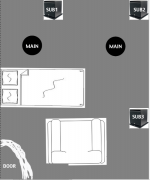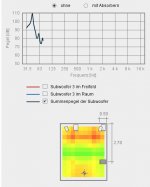Such tools are great at showing how source and listener location dramatically affect frequency response. Unfortunately they are of limited use in real rooms where walls aren't perfectly rigid and rectangular.
Yes I will try this and post it. Also I will measure nearfield each sub to know exactly what it is their response. As for the file I sent to your email that I found in internet in your site.There doesn't seem to be much low frequency output at all?
Did you try the near field configuration described at http://www.diyaudio.com/forums/mult...alization-bass-small-rooms-5.html#post3458938
P.S. Zip the .mdat and upload it here (if it's within file size limits).
I will try this and post the results. Thx for your help!Can you switch polarity separately on the subs? You might find a combination of polarities that give you a smoother response. Worth a try.
As for the file I sent to your email that I found in internet in your site.
Received it.
Hi Murillo,
I made two additional simulations, one for your current setup and another "optimized" setup. As Marcus already said these are only very simple simulations but they should give you some hints how the three subwoofers will interact with the room.
-Bodo
Attachments
I have CARA room simulation software that does a better job of modeling real rooms. With enough data on the room and the speakers, I may be able to get some good simulations for you.Unfortunately they are of limited use in real rooms where walls aren't perfectly rigid and rectangular.
Good job bodo, thx.Hi Murillo,
I made two additional simulations, one for your current setup and another "optimized" setup. As Marcus already said these are only very simple simulations but they should give you some hints how the three subwoofers will interact with the room.
-Bodo
I have CARA room simulation software that does a better job of modeling real rooms. With enough data on the room and the speakers, I may be able to get some good simulations for you.
Ok pano, here it is
THE ROOM:
3,30M WIDTH (10.8 foot)
4,00M DEPTH (13,12 foot)
2,80 HIGH (9,18 foot)
Acoustic Treatment: Nothing except my bed, sofa, books and chairs.
############################
THE SPEAKERS:
DRIVERS:
JBL 2215H 15INCH WOOFER
Sens. 94.1dB
SCANSPEAK 8545 MIDWOOFER
Sens. 88dB
SCANSPEAK ILLUMINATTOR TWEETER 6600
Sens. 91.4dB
CROSSOVER: BEHRINGER ACTIVE CX3400 24 L-R
CROSSOVER POINTS: 300Hz - 3kHz
Amplifier: DIY 6 mono amps to feed the 6 drivers.
All drivers are matched to 92dB in the crossover level adjustment.
The Midwoofer are working with inverted phase in the behringer, I noticed it's better.
Speaker Size: 170 liters each.
Port tuning: 30Hz.
Position of the speakers:
Toe-in: 25 degrees
Side wall: 30cm (1 foot)
Back wall: 90cm (3 foot)
######################
THE SUBWOOFERS
2 sealed 1 cu.ft. (28,5 liters) w/ DAYTON Audio RSS265HF-4 10" Reference
Dayton Audio RSS265HF-4 10" Reference HF Subwoofer 4 Ohm
1 sealer SVS SB-12NSD
SB12-NSD - SVS
Amp for Dayton: Behringer Inuke 3000
Behringer: iNUKE NU3000
2 x 880W RMS 4 OHMS
Crossover: Behringer DCX2496
Level / Phase / EQ / Delay INDIVIDUAL adjustment for each sub.
#####################
LISTENING POSITION
50cm from the back wall.
the game started...
Unfortunately they are of limited use in real rooms where walls aren't perfectly rigid and rectangular.
And furniture - a not insignificant feature in most rooms.
Murillollirum - remember that if you move the subs the data that you send me is no good any longer. SInce you have to redo it all anyways (the HOLM data was no good for some reason) you can move the subs arround and retest. But once you run the test in HOLM you need to leave the subs where they are or the DCX settings won't be any good any longer.
I will say that I have not found sub location critical. With EQ you can make any three sub system work equally well no matter where you place the subs. The EQ will be different in every case, but thats all.
Last edited:
And furniture - a not insignificant feature in most rooms.
Murillollirum - remember that if you move the subs the data that you send me is no good any longer. SInce you have to redo it all anyways (the HOLM data was no good for some reason) you can move the subs arround and retest. But once you run the test in HOLM you need to leave the subs where they are or the DCX settings won't be any good any longer.
I will say that I have not found sub location critical. With EQ you can make any three sub system work equally well no matter where you place the subs. The EQ will be different in every case, but thats all.
Dr. Geddes, yes I know that, I did not move any sub, they are exactly the position where I did the measurements and sent to you. What is the problem with the holm meaurements? Please tell me how to correct that I will do it again. I had some difficult when adjusting the input volume, every measurement returns that there was a clip. any idea?
These are my new measurements with REW, I measured is two ways, first at the nearfield, with the mic in front of the subwoofers, and second in the listening position with the interaction of the room.
I thing I noticed is: AT NORMAL PHASE THE BASS SIMPLE DOES NOT EXISTS! BUT WHAN I CHANGE THE PHASE TO 180 AT ALL SUBS THE BASS INCREASES A LOT. COULD SOMEBODY EXPLAIN THIS?
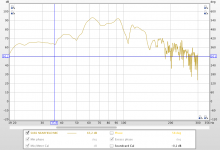
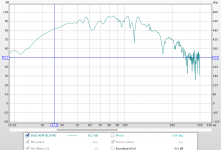
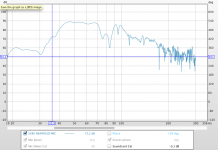

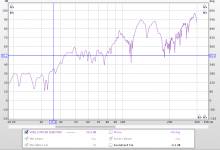
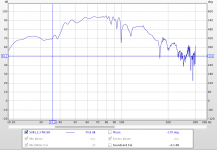
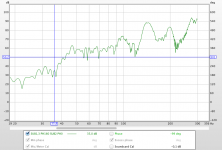
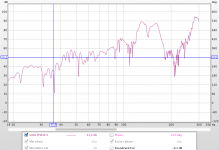
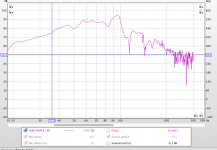
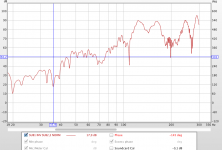
How close did you place the mic for those nearfield measurements?
About 2 inches from the cone
About 2 inches from the cone
Mic should be placed closer than 11% of the effective cone radius (D'Appolito).
What is the problem with the holm meaurements? Please tell me how to correct that I will do it again. I had some difficult when adjusting the input volume, every measurement returns that there was a clip. any idea?
This means that the signal level going into the computer sound card is too high - too much gain on the mic preamp. If the software reports a clip then the data is no good. You sometimes need to use the windows mixer to lower the input sensitivity of the sound card. You have to play around a little bit with all these gains to get it right, but once you find the correct settings you just leave them. Make sure that you use the loudest source to set the gains or you will clip again and have to start all over.
Are you running the mains during this measurement? It looks like you are. If so, there is your answer. 😉AT NORMAL PHASE THE BASS SIMPLE DOES NOT EXISTS! BUT WHAN I CHANGE THE PHASE TO 180 AT ALL SUBS THE BASS INCREASES A LOT. COULD SOMEBODY EXPLAIN THIS?
Thanks for the room dimensions, I'll enter them into CARA and we'll see what it thinks. Funny that you gave the measurements in Imperial, CARA prefers metric. Oh, I see you gave both.
What are the walls and floor made of?
You might not have to move anything, just use Geddes EQ.
Your measurements looks weird ot me. It is not common to have 20-30dB variation in NF measurement in SW's passband.
I made multi sub adjustment according to procedure described by Earl - adding SW one by one (available on Markus76 site). My "variation" was using noise with averaging for adjustment. It helps you to display EQ changes in real-time and give you an idea to sort out the modes. Draw it on the paper including "trends" EQ can make. Nevertheless it last hours to do something kind of acceptable - mine last whole evening to get this at least:

red= average, green= prime location, grey and beige= secondary (-10dB).
I made multi sub adjustment according to procedure described by Earl - adding SW one by one (available on Markus76 site). My "variation" was using noise with averaging for adjustment. It helps you to display EQ changes in real-time and give you an idea to sort out the modes. Draw it on the paper including "trends" EQ can make. Nevertheless it last hours to do something kind of acceptable - mine last whole evening to get this at least:

red= average, green= prime location, grey and beige= secondary (-10dB).
Are you running the mains during this measurement? It looks like you are. If so, there is your answer. 😉
Thanks for the room dimensions, I'll enter them into CARA and we'll see what it thinks. Funny that you gave the measurements in Imperial, CARA prefers metric. Oh, I see you gave both.
What are the walls and floor made of?
You might not have to move anything, just use Geddes EQ.
Hi Pano, the walls are concrete made. There is a glass window at the back wall. Yes, I will not move anything, I will stay will Dr. Geddes recommendation. I'm not using any type of EQ or phase, delay adjustments. Dr. Geddes will give me the parameters after analysing my data.
How close did you place the mic for those nearfield measurements?
Markus thx for your precise info, I will not do more measurements today, I'm really tired man, I think I will drink a heineken now. 🙂
Man, how difficult to have a good bass, I thought it was easier... 😎
- Status
- Not open for further replies.
- Home
- Loudspeakers
- Multi-Way
- DCX2496 EQ Tips... Does anyone had success with Equalization of bass is Small Rooms?
